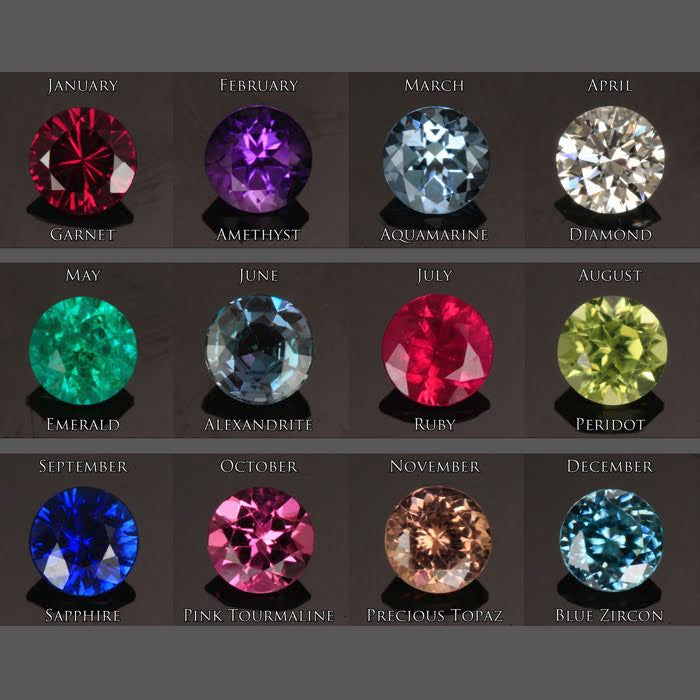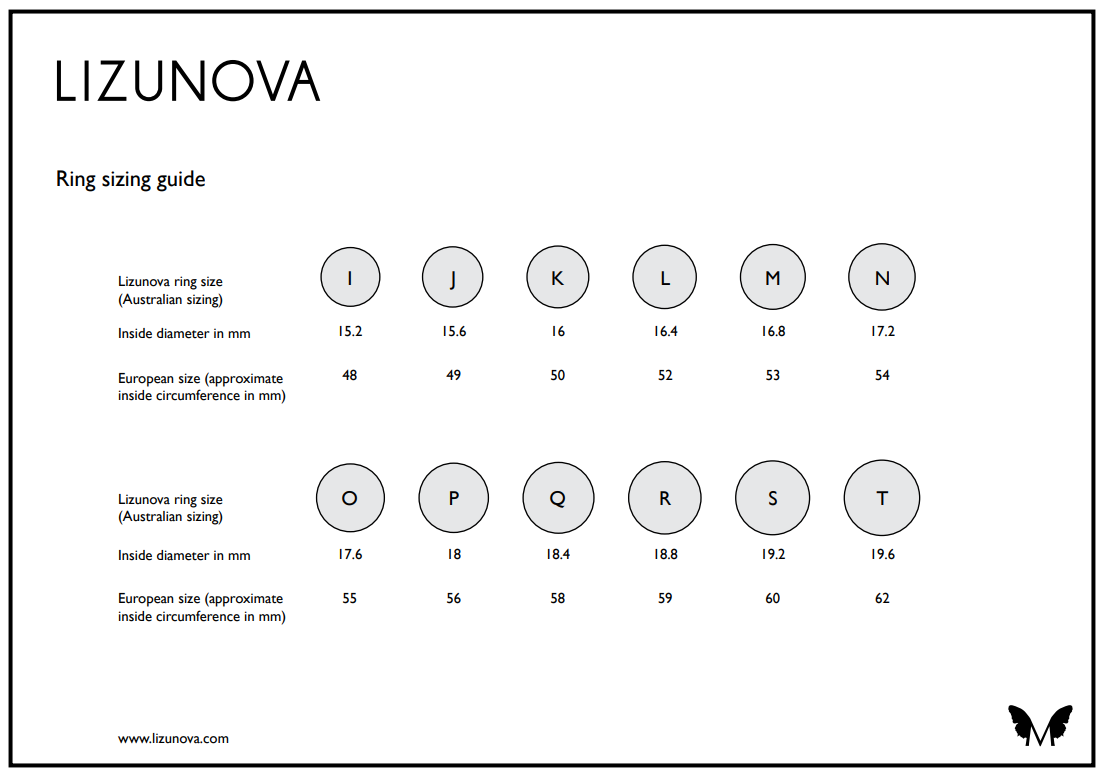For thousands of years gemstones have held a special fascination for humankind. Prehistoric man decorated himself with shells, bones, feathers and sometimes gems in their raw state. The Ancient Egyptians and Sumerians were very sophisticated civilizations that were able to cut and polish gems and fashion them into incredibly intricate jewellery that rivals our modern jewels and still is a source of inspiration.
Historians believe that the concept of birthstones or a particular gem being allocated to each month relates back to Biblical times when the high priest of the Israelites wore the sacred priestly breastplate. This intricate breastplate was adorned with twelve gemstones set in four rows of three gems that were engraved and woven into the fabric of the plate. Twelve different minerals were selected, each one representing one of the twelve tribes of Israel. Scholars argue which minerals were used and it's theorised that they were mostly ornamental stones of lower hardness as they were all engraved.
Over the years the tradition was modified for an allocated gemstone to represent each month. Here we will explore which gemstone classically represents each calendar month and some more modern alternatives as we may not favour our particular assigned birthstone.
JANUARY
The gemstone assigned to January is garnet. This will displease many as most people believe garnets to be rather dull, dark red gems of little value and beauty. In reality, the garnet family is vast and diverse and garnets come in nearly all colours except a true blue. There exceptionally rare garnets that display colour change from teal green to reddish steroidi anabolizzanti prima e dopo purple and others that display asterism (a mostly four-rayed star) or chatoyancy (a cats-eye effect). Garnets were believed to protect warriors in battle and protect against wounds in both Native American Indian cultures and during the Mediaeval period in Europe. However, if garnets just dont appeal, other birthstones that represent January are rose quartz, emerald (according to Tibetan astrology) and yellow or blue sapphire (according to jyotish astrology.)
FEBRUARY
February is assigned the beautiful purple quartz known as amethyst. Some will be disappointed thinking that amethyst is cheap and abundant unlike ruby or emerald. However, in past times, amethyst was a very rare gem that was highly valued in a similar fashion to ruby, emerald and sapphire. Purple was the colour of royalty and higher consciousness and can be found set into crown and religious jewels. The ancient Greeks associated amethyst with wine and believed that wearing the gem prevented drunkenness. When the vast deposits of amethyst were discovered in Brazil by German settlers during the 19th century, the gem sadly lost its value (although on the bright-side it's beautiful and affordable!!) Bloodstone is an alternative gem which is very masculine and great for signet rings. If you are an Aquarian ruled by Saturn you can select blue sapphire as your birthstone according to jyotish astrology.
MARCH
The gemstone associated with March is the highly attractive pale blue- green gemstone known as aquamarine. This beautiful gem reflects the colours of shallow ocean water and is part of the beryl family, which also includes emerald. Aquamarine can be a very pale soft blue or a richer sky blue. The most prized aquamarines have a natural, saturated blue green colour such as the famous stones mined from Santa Maria, Minas Gerais in Brazil. During Medieval times people believed that aquamarine protected couples in love no wonder that it's such a popular choice for alternative engagement rings these days. Aquamarine was meant to protect sailors on the high seas and it was even believed that mermaids kept them hidden in their secret treasure troves. However, if you don't like aquamarine you can choose from jasper or jade (great choices for men!). According to jyotish astrology those in early March can choose blue sapphire and yellow sapphire for the second half of the month.
APRIL
If you are born in April you'll be delighted to know that your assigned birthstone is diamond. Few people would be upset by this choice as diamond remains the Western world's most prized gem. Diamond fully deserves its reputation as the king of gems, with a hardness of 10 on the Mohs scale, its powerful dispersion and good tenacity, it is hard wearing and perfect for ring settings. You may be surprised to know that diamonds come in all the colours of the rainbow, not just colourless stones. Some diamonds are blue due to traces of boron in the crystal lattice while others are yellow due to nitrogen. The famous and highly prized pink diamonds from the Argyle mines in Australia are theorised to be coloured due to enormous pressures that cause disruption in the crystal lattice as the gems are pushed up from the Earth's mantle. If you don't like bling or would like an interesting alternative gem, you could try opal according to Tibetan traditions or precious red coral according to jyotish astrology.
MAY
The month of May is emerald month. Emeralds have been highly prized by man since the time of Cleopatra and her famous emerald mines. These rare gems have been coveted by royalty for centuries. Emeralds became all the rage when the conquistadores invaded the New World during the 1500s and started pirating the mines at Muzo in Colombia. These emeralds were of much higher quality than the Ancient Egyptian material as they were rich in the transition element, Chromium, and were a rich vibrant, velvety green. At first the invaders believed the gems to be harder than diamonds and many were smashed by anvils as they being tested. Green is the colour of the heart chakra and is thought to represent love. Emerald was a popular choice for engagement rings before diamonds took off in the 20th C: Prince Albert presented Queen Victoria with an emerald set snake design ring upon their engagement in 1840. Not everyone likes the colour green, so alternative birthstones are rich orange carnelian or diamond (Jyotish astrology).
JUNE
Those born in June have pearls, the most prized of the organic gemstones, as their birthstone. Organic gemstones are created by animals such as molluscs and coral polyps or by plants substances that have gone through processes of carbonization (jet) or petrification (amber). Pearls have been prized by man since antiquity and until the 20th C were exceedingly rare as the molluscs take years to produce a pearl and this would be due to the unlikely chance of a parasite entering the animal's outer shell. Divers would be very lucky to find them. These days, nearly all pearls on the market are cultured and farmed by man which means they are accessible to most people. Australia produces the most magnificent silver to white South Sea pearls which are the best in the world. Pearls have a unique luminescent lustre that has often been likened to the light of the moon thus they are strongly associated with the feminine. Not all pearls are white: there are beautiful golds, greys, blacks and iridescent peacock greens to choose from. If pearls are too feminine or don't suit you alternative birthstones are: alexandrite the incredibly rare chrysoberyl which changes colour in different light sources as well as chalcedony and agates which are more masculine choices.
JULY
Those born in July are allocated the most passionate and sexy gemstone, ruby. Ruby has always symbolised passion and love and has been associated with blood our life force. In Sanskrit ruby is known as ratnaraj or king of precious stones. The Hindus believed if they offered fine quality rubies to the God, Krishna, they would be granted a position as Emperor in their next incarnation. Rubies became associated with love, passion and wealth in Western cultures during the Middle Ages. Few people realise that ruby is part of the Corundum family and her sibling is sapphire (which comes in all colours of the rainbow.) Ruby is basically aluminium oxide that has been coloured red by Chromium. The chromium imparts ruby with a fire like glow that can look almost neon in sunlight. The most famous rubies are from Mogok in Myanmar, formally known as Burma. Alternative birthstones are Carnelian and onyx which are more affordable and suit both sexes. In jyotish astrology the allocated birthstone is pearl.
AUGUST
Many born in August dislike their allocated birthstone, the pretty green gem named peridot, which seems a shame as it has a long interesting history and gem quality material has even been found in meteorites! Peridot is from the Olivine family of minerals and has been associated with light. It was venerated by the Ancient Egyptians who named it gem of the sun. This is perhaps why it has been allocated to August and is associated with the Western astrological sign, Leo, whose ruling planet is the Sun. Peridot owes its verdant green colour to iron and during history was often mistaken for emerald. It's theorised that the emeralds from Cleopatra's mines may have been peridot. Peridot was believed to guard against curses and enchantments and that its powers were at their full potency when set into yellow gold. Many people don't like to wear the colour green however there are plenty of alternatives to choose from. The Hindus have ruby as the birthstone for August and other choices are onyx and sardonyx. If you believe in Guardian angels you can choose diamond, which represents the angel, Humatiel who is assigned to August.
SEPTEMBER
September is sapphire month so if you are a September birthday you get to wear one of the world's favourite gems as your birthstone. Most people know sapphire as a mid to dark blue gemstone however sapphires come in all different colours except for red (red corundum is known as ruby!). Sapphires that come in colours beside blue are known as fancy sapphires and the most popular colours are pink, yellow and padparadscha, which is a unique orangey pink sapphire which hails from Sri Lanka and has been named after the lotus flower. Sapphires can display interesting phenomena such as asterism (usually as a six- pointed star however some sapphires can display twelve points), colour change (from blue to purple being the most common) and strong colour zoning (these are the parti sapphires which can be strongly banded or zoned in yellows, blues and greens.)
Traditionally sapphire has symbolised loyalty, fidelity, faithfulness, nobility and truth thus these precious gems have adorned the robes of royalty and the priesthood over the centuries. In ancient Greece and Rome it was thought that owning sapphires guarded one from envy and harm while during the Middle Ages sapphire came to symbolise the heavenly energies. During recent times The British Royal family has made blue sapphire a popular choice for engagement rings due to the popularity of Princess Diana and now the Duchess of Cambridge. As sapphire has a Mohs hardness of 9 it's incredibly durable and suitable for wearing in a ring setting everyday.
If you wanted an alternative to sapphire you could wear moonstone according to Ayurvedic traditions or Zircon according to the Hindu birthstone list.
OCTOBER
If your birthday falls in October then you are certainly spoiled for choice when it comes to selecting your birthstone. The two choices are opal and tourmaline both of these gems are truly kaleidoscopic!
Opal is one of the rarest and most fascinating gems of all. Australia is blessed with 90% of the finest precious opal including the famous black opal from Lightening Ridge in NSW. Precious black opal has a black body colour and can sometimes display all the spectral colours when viewed from different positions. This kaleidoscopic effect is known as play of colour and is due to the diffraction of light through spheres of silica in the atomic lattice of the gem. Vivid greens and blues are the most common colours while flashes of red are the rarest. Some precious opals can display distinct patterns such as Harlequin and Chinese Writing.
Tourmaline is the rainbow gem that appears in a myriad of colours. Reds are known as Rubellite, teal blues as Indicolite and a stunning bi-coloured gem with distinct colour zones of pink and green as Watermelon tourmaline. Other colours are golds, browns, Blacks, greens, oranges and pinks. The most prized tourmalines of all are known as Paraiba tourmaline. These stunning gems are coloured with traces of copper which give them a neon blue through to blue green colour which is highly prized among collectors. Named after the Paraiba district in Brazil from where they are mined, they will knock you out with their beauty.
If neither tourmaline or opal appeals, you can choose beryl according to Italian traditions or coral according to the Hindu birthstone list.
NOVEMBER
November's birthstone choices are very versatile as they include topaz and the golden quartz called citrine. The topaz family of gems is incredibly versatile with the head of the family being Imperial Topaz. Imperial Topaz is a divine sherry coloured gem whose rich golden through to orange and pink colours are thought to resemble the setting sun. In 17th century Russia natural pink topazes were reserved solely for the Tsars hence the name. They are the rarest and most expensive of the topaz family and the main sources are Ouro Preto in Brazil and the Ural Mountains in Russia.
Topaz also comes in a brilliant range of blues including a sky blue that is similar to aquamarine; a Swizz blue that is a dazzling electric blue and London Blue, which is an uber fashionable dark teal that goes with all colours. Most people love wearing the colour blue so it's a good choice if you are thinking of buying a gift for a November birthday
If you love yellows and golds, you could select citrine as your birthstone. This popular golden quartz is very affordable and is available in big carat weights perfect for statement cocktail rings. Citrine is found all over the world including Australia, however the most important world source is Brazil. Citrine is thought to be a gem that brings good fortune to business and is known as the Merchant's Stone so also a perfect gift choice that may bring abundance to the lucky recipient.
If none of those appeal you could consider red coral, carnelian or cat's-eye gems according to Hindu astrology. These three choices are also great for male jewellery pieces.
DECEMBER
If you have a birthstone in December here's hoping that you are keen on the colour blue! Traditionally the allocated birthstone for this month since the Middle Ages has been blue zircon. Zircon is a very under- appreciated natural gemstone that many people confuse with the synthetic gem, cubic zirconia. Zircons have amazing dispersion, which mean they can split up white light into its spectral colours in a similar fashion to diamond, hence they have a diamond-like sparkle. It was once thought that wearing blue zircon would promote spiritual growth and wisdom and would result in a peaceful existence. These electric sky blue gems look amazing set in 22ct yellow gold.
Turquoise is another December birthstone choice that is very popular with many people. Revered by many Ancient cultures, including the Egyptians, Persians and Aztecs, turquoise is believed to help communicate with the spirit world, promote healing and good fortune. The Native American Indians have used turquoise in their exquisite sterling silver jewellery for centuries, which is now extremely popular and collectible. The stunning bright blue ornamental gems look amazing in shiny sterling silver and really compliment summer clothing. Copper owes its intense sky blue colour to the transition element, copper.
A modern birthstone choice and one that rivals sapphire in the beauty stakes is tanzanite with its dazzling purple/blue pleochroism. The unique appeal of tanzanite was quickly marketed by Tiffany & Co. after being discovered by a Masai tribesman in 1967, in the Merelani district at the foot of Mt. Kilimanjaro. Once the bright blue crystals were tested and were diagnosed to be zoisite rather than corundum (sapphire), the named was changed to Tanzanite as zoisite didn't sound very enticing. Tanzanite has quickly become one of the world's most popular coloured gemstone choices and is often flawless in clarity.
If the colour blue just gets you down you could always try ruby according to Arabic and Hebrew birthstone traditions. Lapis Lazuli makes a nice choice for men as well as traditional turquoise.




